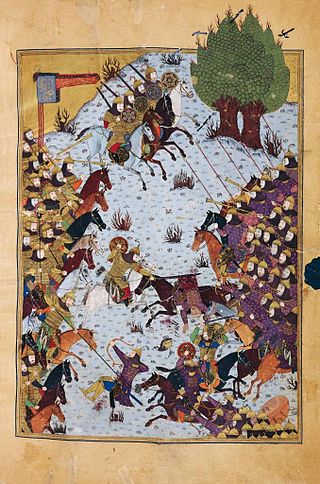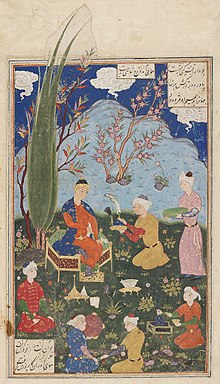
Darius I, commonly known as Darius the Great, was the third King of Kings of the Achaemenid Empire, reigning from 522 BCE until his death in 486 BCE. He ruled the empire at its territorial peak, when it included much of West Asia, parts of the Balkans and the Caucasus, most of the Black Sea's coastal regions, Central Asia, the Indus Valley in the far east, and portions of North Africa and Northeast Africa including Egypt (Mudrâya), eastern Libya, and coastal Sudan.

Darius III was the thirteenth and last Achaemenid King of Kings of Persia, reigning from 336 BC to his death in 330 BC.

Bessus or Bessos, also known by his throne name Artaxerxes V, was a Persian satrap of the eastern Achaemenid satrapy of Bactria, as well as the self-proclaimed King of Kings of the Achaemenid Empire from 330 to 329 BC.

Khosrow I, traditionally known by his epithet of Anushirvan, was the Sasanian King of Kings of Iran from 531 to 579. He was the son and successor of Kavad I.

Yazdegerd II, was the Sasanian King of Kings of Iran from 438 to 457. He was the successor and son of Bahram V.

Ardashir I, also known as Ardashir the Unifier, was the founder of the Persian Sasanian Empire. He was also Ardashir V of the Kings of Persis, until he founded the new empire. After defeating the last Parthian shahanshah Artabanus IV on the Hormozdgan plain in 224, he overthrew the Arsacid dynasty and established the Sasanian dynasty. Afterwards, Ardashir called himself "shahanshah" and began conquering the land that he called Iran.

Vishtaspa is the Avestan-language name of a figure appearing in Zoroastrian scripture and tradition, portrayed as an early follower of Zoroaster, and his patron, and instrumental in the diffusion of the prophet's message. Although Vishtaspa is not epigraphically attested, he is – like Zoroaster – traditionally assumed to have been a historical figure, although obscured by accretions from legend and myth.

Abhar is a city in the Central District of Abhar County, Zanjan province, Iran, serving as capital of both the county and the district. Abhar has historically served as a place of importance due to lying right between the cities of Qazvin and Zanjan.

Kay Khosrow is a legendary king of Iran of Kayanian dynasty and a character in the Persian epic book, Shahnameh. He was the son of the Iranian prince Siavash who married princess Farangis of Turan while in exile. Before Kay Khosrow was born, his father was murdered in Turan by his maternal grandfather Afrasiab. Kay Khosrow was trained as a child in the desert by Piran, the wise vizier of Afrasiab. His paternal grandfather was Kay Kāvus, the legendary Shah of Iran who chose him as his heir when he returned to Iran with his mother. The name Kay Khosrow derives from Avestan 𐬐𐬀𐬎𐬎𐬌 𐬵𐬀𐬊𐬯𐬭𐬀𐬎𐬎𐬀𐬢𐬵𐬀Kauui Haosrauuaŋha, meaning "seer/poet who has good fame".

Pabag was an Iranian prince who ruled Istakhr, the capital of Pars, from 205 or 206 until his death sometime between 207 and 210. He was the father, stepfather, grandfather, or father-in-law of Ardashir I, the founder of the Sasanian Empire. He was succeeded by his eldest son, Shapur.

The Kayanians are a legendary dynasty of Persian/Iranian tradition and folklore which supposedly ruled after the Pishdadians each of whom held the title Kay, meaning "king". Considered collectively, the Kayanian kings are the heroes of the Avesta, the sacred texts of Zoroastrianism, and of the Shahnameh, the national epic of Greater Iran.

Kay Bahman or Wahman is a mythological figure of Greater Iranian legend and lore. The stock epithet Kai identifies Bahman as one of the Kayanian kings of Iranian oral tradition.
Šahrestānīhā ī Ērānšahr is a surviving Middle Persian text on geography, which was completed in the late eighth or early ninth centuries AD. The text gives a numbered list of the cities of Eranshahr and their history and importance for Persian history. The text itself has indication that it was also redacted at the time of Khosrow II in 7th century as it mentions several places in Africa and Persian Gulf conquered by the Sasanians.

Humay-ē Chehrzad was a legendary Kayanian dynasty queen of Iran for around 32 years. She was daughter and perhaps also wife of Kay Bahman.

The Sasanian dynasty was the house that founded the Sasanian Empire of Iran, ruling this empire from 224 to 651 AD. It began with Ardashir I, who named the dynasty in honour of his predecessor, Sasan.
Wuzurgan, also known by its Modern Persian form of Bozorgan (بزرگان), was the name of the high nobility and the third class-rank of the four of the Sasanian aristocracy. After the fall of the Sasanian Empire, they reappear under the Dabuyid dynasty.
Tawwaj, Tawwaz or Tavvaz was a medieval city in Fars (Pars) in modern Iran, located southwest of Shiraz.

Dara II or Darab II was the last king of the mythological Kayanian dynasty, ruling between 14 and 16 years. He is generally identified with Darius III, the last king of the Achaemenid Empire. In Middle Persian literature and Islamic chronicles, he is generally known as "Dara", while he is known as "Darab" in the New Persian proses Darab-nama and Iskandar-nama. He was the son and successor of Dara I.

Turya or Turanian is the ethnonym of a group mentioned in the Avesta, i.e., the collection of sacred texts of Zoroastrianism. In those texts, the Turyas closely interact with the Aryas, i.e. the early Iranians. Their identity is unknown but they are assumed to have been Iranic horse nomads from the Eurasian steppe.

















